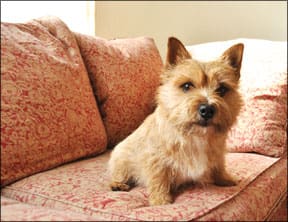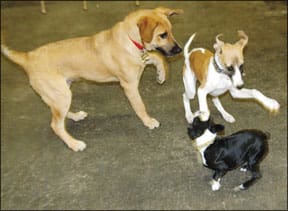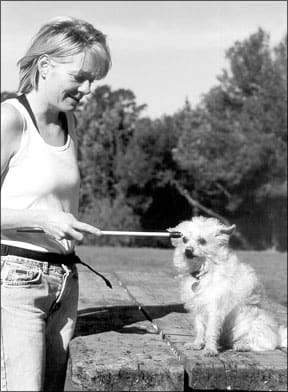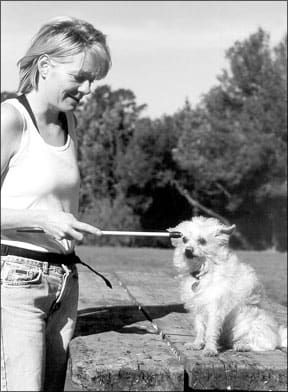There’s a reality show that airs on TLC called Little People, Big World that chronicles the daily lives of the Roloffs, an Oregon family made up of both small (both parents are under 4 feet tall) and average-sized people. The series tastefully portrays how every day activities and seemingly uneventful situations can affect the family members differently based on their size and how society views them. Most importantly, it successfully shows that size does matter, particularly in a society built for the average-sized person. I just wish there was a show, or at least an effective way to get that point across regarding small dogs. They and their owners have long been misjudged and misunderstood.
288
According to the 2009 American Kennel Club registration statistics, nearly half of the top 20 breeds are small dogs that weigh less than 20 pounds at full adulthood. This appeal makes a lot of sense. Small dogs are much more portable and can be taken virtually anywhere, even to places where dogs usually aren’t allowed (not that I advocate that). They require less space, making them a viable choice for apartment or condo dwellers. They’re much easier to exercise; a regular-sized room can easily be converted to a play area without moving even a single piece of furniture.
Despite all this, intolerance and a lack of understanding of smaller dogs is prevalent in society. Stereotypes deem them “snippy,” “yappy,” and “bratty” – and perhaps the most cutting of all, “not even real dogs.” I’ve heard this even from people who consider themselves dog lovers!
Small dogs and those who choose to share their lives with small dogs are different. Throughout my 25-plus years as a professional in the field of dog behavior and training, it’s been my experience that small dog owners do tend to be much more protective of their dogs (sometimes to the point of being overprotective) and are less likely to socialize their dogs or attend group training classes. They also tend to be more tolerant of – and apt to make apologies and excuses for – their dogs’ inappropriate behavior.
Before you write me off as just another one of those little dog haters, let me also say that I currently share my household with three Malteses: 9-lb. Leo, 7-lb. Andrew (with whom I appeared on the CBS show “Greatest American Dog”), and Geoffrey, who at five years of age still barely tips the scale at 3 pounds. However, I also have four big dogs, and have had large dogs for most of my life, affording me the opportunity to see both sides of the spectrum. But unfortunately, throughout all my years teaching group training and socialization classes, I’d estimate that the owners of small dogs (15 lbs and less) make up barely 10 percent of the people who come to – or even inquire about – my classes. In fact, it’s probably closer to 5 percent. That’s very sobering.
Unfortunately, it’s also understandable. Stop in and look at an average puppy kindergarten class; what you’ll usually find will be a boisterous 15-week-old Labrador Retriever puppy jumping all over his owner on one side of the room, a Shepherd-mix lunging at the Husky pup bouncing on the other side of him, and then there might be an already 40-lb. Rottweiler puppy dragging her owners through the door. All the new puppy parents are clearly having difficulty trying to maintain control of their dogs while holding onto the leash and a bag full of treats.
Is it any wonder that this environment might be uninviting for the new, nervous parent of a 4-lb. toy Poodle puppy? Subsequently, many owners of small dogs never return to that or any other training class or socialization session. As a result, too many toy breed and small dogs miss out on crucial training and positive socialization experiences at the time they need it the most, which in turn leads to the undesirable behaviors we sometimes see in small dogs that perpetuate the stereotypes.
This is why I say “bravo” to any trainer or facility that includes “Mighty Mites” or “Tiny Tots” classes, geared toward the small dog, in its programming. While these types of classes may not be as prevalent as I’d like, I do encourage small dog owners to seek them out. If no class exists in your area, go and talk to your area trainers and request one, or at least find out if they provide modifications for the smaller dog in their regular classes.
That said, failure to find a suitable group class for you and your little dog is not an excuse to fail to train your small dog! By being proactive and tweaking your training environment a little, you can successfully train your small dog at home, or even better, manipulate and modify the environment in a regular group training class to meet your dog’s specific needs.
288
Level the training field
Have you ever really tried to imagine how different the environment looks to a dog who stands less than 10 or 12 inches tall? Undoubtedly everything and everyone likely looks bigger and much farther away. Just for a little perspective, try placing an alarm clock at the top of a 20 foot ladder. Then get down on all fours and look up. How far away does that clock look to you now? Is your neck feeling a little strained? Are you finding it difficult to read the numbers? All in all, it’s just not very comfortable, is it?
That’s just a small glimpse of what it might be like for a little dog to look at your face and try to decipher your expression. Getting and keeping your dog’s attention is paramount in training, and it’s difficult to accomplish that with a dog who finds it physically uncomfortable to look up at you. It’s also uncomfortable for a handler – especially if she has a bad back – to bend over (almost to the floor) again and again.
Therefore, the first thing that must be done is to give that dog a boost, helping him get closer to you – and especially your hands, which give cues and deliver treats and petting as rewards. Placing the dog on a table or chair is a good option. I love to “sofa train” my little ones with quick little training sessions while they’re sitting on the sofa with me. This makes the sofa much more than a place to cuddle; now it becomes a special place to work and have fun as well.
Another great option is to grab a yoga mat and have a seat on the floor next to your dog. Again, establishing focus and attention will be easier when both of you are closer to each other. These options are good starting points to introduce behaviors, and just like shaping any other behaviors, you can gradually bring the dogs’ focus upward until you’re eventually standing in a full, upright position.
On target
Something that should be in every small dog owner’s toolbox is a target stick. Since our arms only reach so far, and constantly bending over can literally be a pain, extending your reach by two or more feet can be a lifesaver.
Target sticks add this extension and can be used as a lure or focal point for your small dog. They can be purchased ready-made or can be fashioned from a wooden dowel with a baby spoon taped onto the end. I’ve even seen some people use a back scratcher as a target! Rubbing a high value food (like squeeze cheese, soft cream cheese, or peanut butter) onto the end of the stick will “load up” the target stick and make it an object of desire for your dog. Soon, the dog will follow that stick anywhere. Suddenly, teaching loose leash walking becomes much more manageable. You can click and reward the small dog without breaking a stride. Like any lure, the target stick can and should be faded once the dog has learned what position is the most rewarding.
With a little creativity you can find additional items that can be used as training aids for small dogs, most of which are inexpensive and readily available. You can set up a mini-agility course using those small, portable tunnels intended for toddlers, plungers for weave poles, and shoe boxes for tables or pause boxes. Dogs of any size love to run, jump, and go through tunnels, but most importantly these kinds of activities are great for relationship-building and instilling confidence.
Even little dogs have noses, so why not try some scent discrimination activities? Place treats in a mini-muffin tin and then cover the treats by placing mini tennis balls or ping pong balls on top. Encourage your dog to sniff the tin and “find” the treats by moving the tennis balls and claiming his reward. Almost anything you’d use for training a larger dog can be modified and downsized for a smaller dog if you use your imagination.
288
Social work
The importance of socialization cannot be disputed. Unsocialized dogs are often fearful and socially inept; they have difficulty reading the body language signals of other dogs or performing appropriately friendly signals themselves. Those small dogs who bark and snarl and kick up a fuss when they see other dogs – especially dogs who are much bigger than they are? They are displaying fear-based aggression, but their behavior endangers themselves and their owners if they antagonize another dog into starting a fight. And dogs of any size who get scared and snap at people often end up getting permanently left at home, or surrendered to a shelter.
Here’s the bottom line: if you want your small dog to be comfortable with people and other dogs, you must socialize him or her, and as early as possible. Again, your goal is to find a group puppy class conducted by a knowledgeable instructor who knows how to provide a positive socialization experience for all puppies, regardless of size. However, if you can’t find a class like this, you need to create opportunities for yourself. There are many small dog “meet up” groups. You can find them through an Internet search, or through your favorite veterinarian, trainer, or independent pet supply store.
Before participating in one of the socialization sessions, though, attend without your dog and speak with the participants and facilitator. Surely some of them have puppies, so inquire about setting up a playgroup for the puppies only. If other small breed puppies can’t be found, don’t count out larger breed puppies. Gentle, calm, and easygoing puppies of all breeds do exist, and frankly, positive interactions with dogs who are larger than your pup are just as important (if not more so).
If your small dog is already an adult and has problems getting along with other dogs, seek out an experienced behavior professional. Counter-conditioning and desensitization exercises and other training can increase your dog’s comfort with other dogs and improve his response.
Even though your dog should be able to get along with other dogs (of any size), for his own safety, it’s best to exercise and socialize him at dog parks that have a special section for small dogs. Sadly, we’ve heard numerous reports of small dogs getting injured and even killed by larger, overstimulated, and predatory dogs in dog parks.
Smaller is good, too
I’ll be the first to admit that I do have a different kind of relationship with my little dogs than I have with my larger ones. A little dog’s size and dependency on us does promote a kind of intimacy that is hard to explain to someone who hasn’t experienced it. Remember how much you loved to coo, cuddle, and pick up your Golden or Labrador puppy when he was small? Can you blame a small dog owner for enjoying those experiences throughout her small dog’s life?
Further, if I have to maneuver through a crowd or need to get from point A to point B quickly, I’ll hoist my small dog into my arms so I can get to my destination faster. I don’t do it because I’m too lazy to get my small dogs to walk on lead politely. I do it because it’s more convenient – and because I can!
Despite my years of experience with dogs of all sizes, I consider myself fortunate to have experienced all the joys of sharing my life with my little (and well-trained and well-socialized) dogs. No matter how much you love your small dog, I’d be willing to bet that you would enjoy her even more if she were better behaved, so get busy training!
Laurie C. Williams is a dog trainer, rally obedience judge, and owner of Pup ’n Iron, Canine Fitness and Learning Center, in Fredericksburg, Virginia. See “Resources,” page 24, for contact information.






